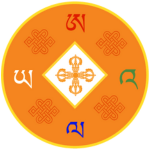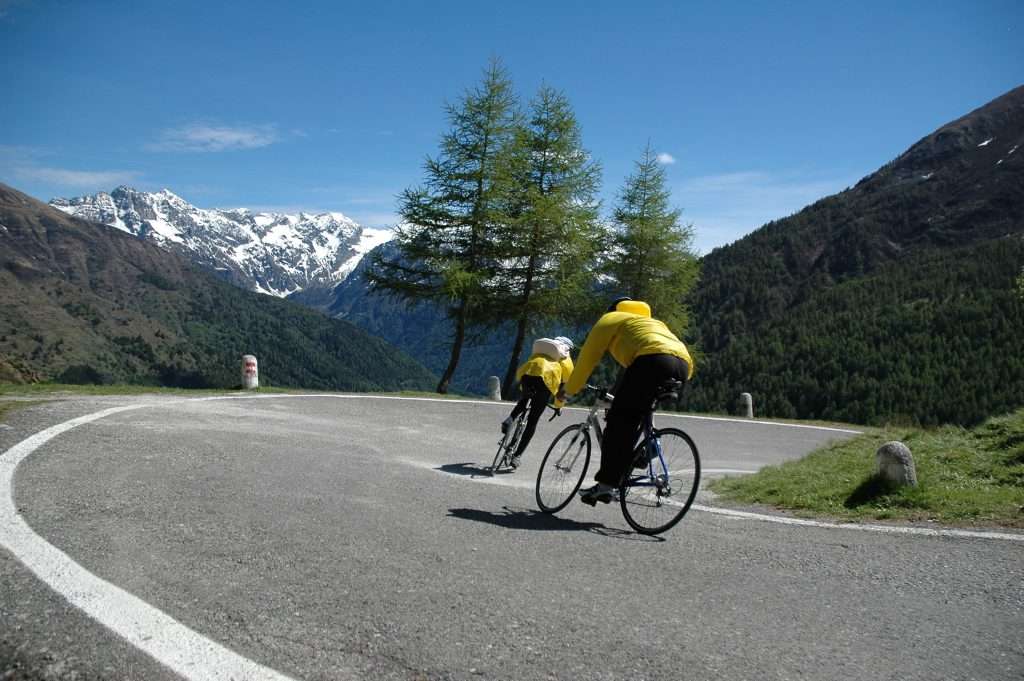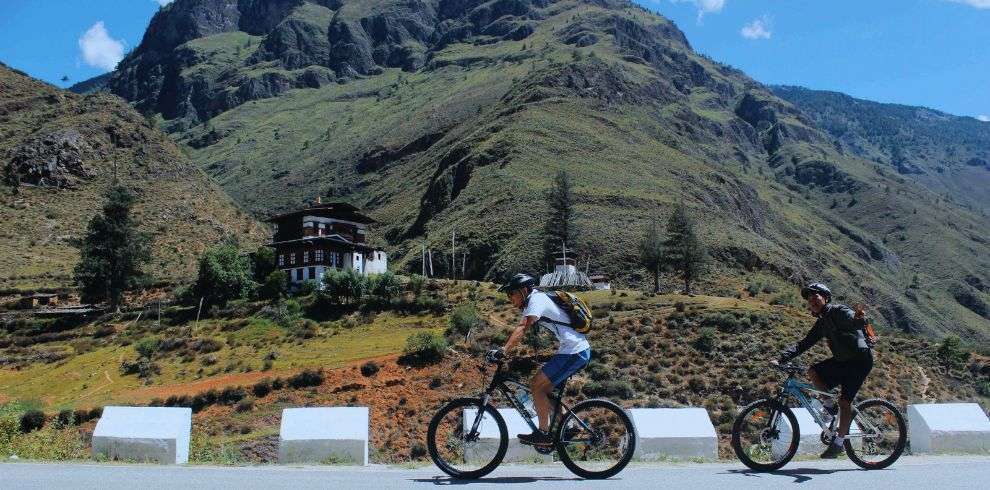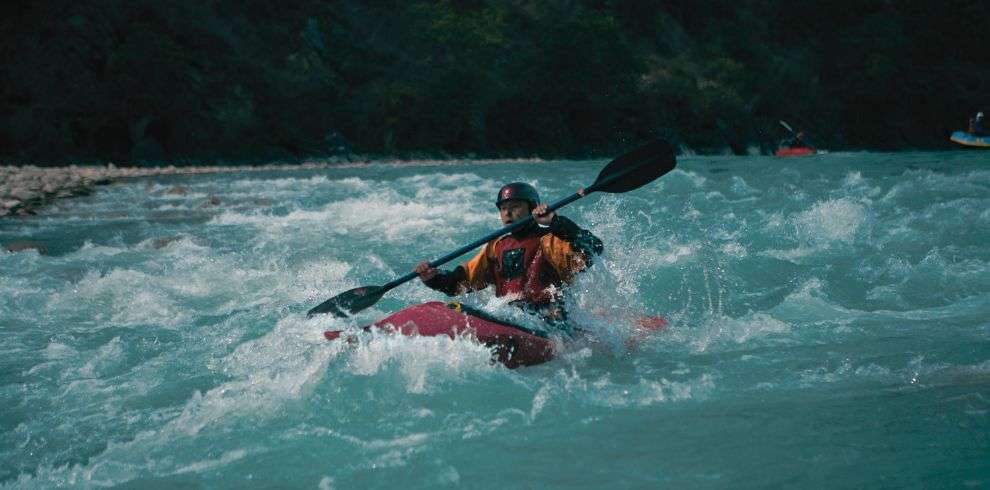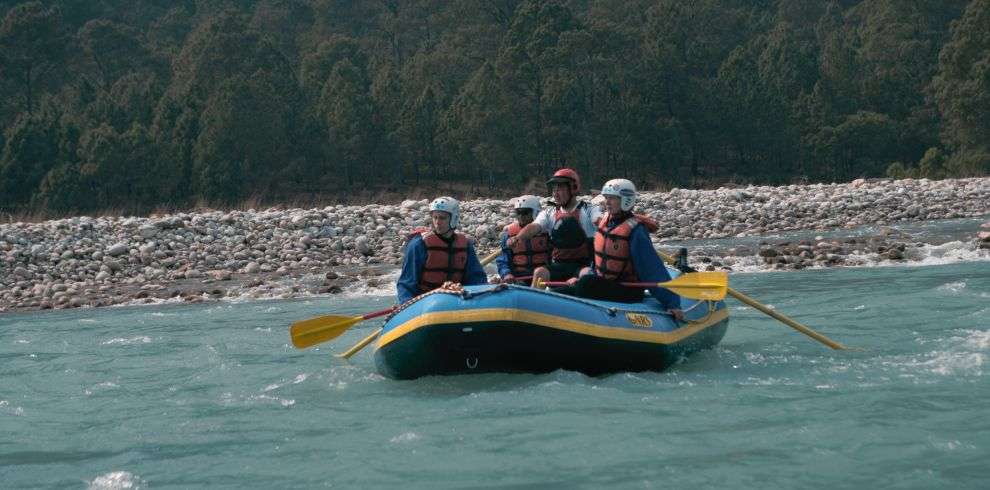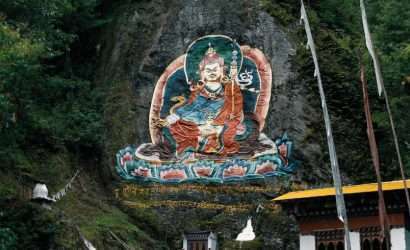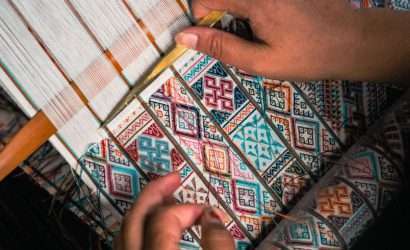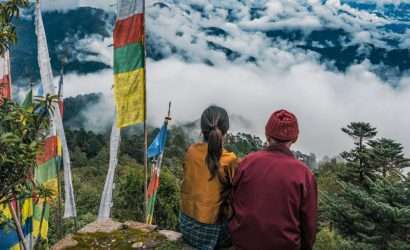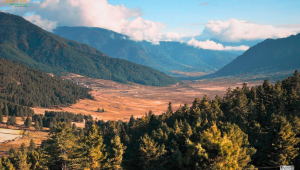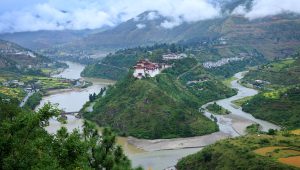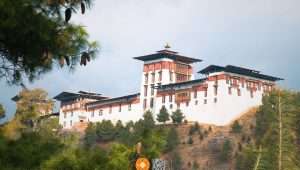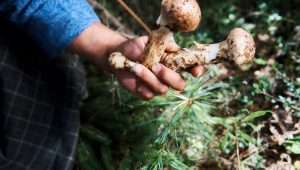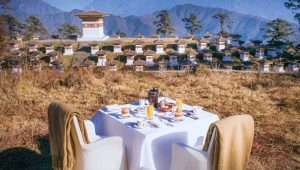Bhutan’s mountainous geography and rugged topography provide exciting opportunities for adventure activities of all kinds.
From hiking, trekking, and kayaking to river rafting, mountain biking, and fishing, the choice is abundant. Bhutan truly offers a one-of-a-kind experience for travelers seeking adventure in an unspoiled and unexplored environment.
You can ask us to make the adventure activities interesting for your tour in Bhutan. We can put together to experience in your lifetime the most challenging and the toughest of the Bhutan cycling race. There will be many foreign bikers taking part in it every year along with the Bhutanese daredevils. The route across the Inner Himalayas of Bhutan is one of the most grueling ones in the world. The route is as winding as the body of a Bhutanese dragon, curving not only laterally but also in terms of elevation – spiking up to 3,340m and dropping to 1,200m.
Overview
From hiking, trekking, and kayaking to river rafting, mountain biking, and fishing, the choice is abundant. Bhutan truly offers a one-of-a-kind experience for travelers seeking adventure in an unspoiled and unexplored environment.
You can ask us to make the adventure activities interesting for your tour in Bhutan. We can put together to experience in your lifetime the most challenging and the toughest of the Bhutan cycling race. There will be many foreign bikers taking part in it every year along with the Bhutanese daredevils. The route across the Inner Himalayas of Bhutan is one of the most grueling ones in the world. The route is as winding as the body of a Bhutanese dragon, curving not only laterally but also in terms of elevation – spiking up to 3,340m and dropping to 1,200m.
Itinerary
Flight into Paro with Druk Air or Bhutan Airline presents you views of the awesome peaks, including the sacred Jhomolhari 7314m and Jichu Drake 6794m peaks in Bhutan. On arrival, our representative of ALAYA & Team will greet you.
You will drive to Thimphu; your first stop will allow you to view picturesque TachogLhakhang, the hereditary place of worship for Bhutan’s Iron Bridge Builder, and further drive we will reach Chuzom marks by the confluence of Paro Chu (river) and the Wang Chu. Opposite of you, at the confluence, are three evil protecting chortens each built in a different style. Evening stroll through the market and mingle with the local people and visit shops.
Overnight stay in a hotel, Thimphu.
Start your day in Thimphu with a visit to the National Memorial Chorten, a stupa dedicated to world peace and prosperity in 1974 in memory of the Third King of Bhutan; the National Institute of Zorig Chusum where students undergo a training course in Bhutan’s 13 traditional arts and crafts; Folk Heritage Museum which will provide an insight into the traditional Bhutanese farm house and rural past through exhibits and documentation of rural life.
Afternoon visit Takin Reserve Centre to see the rare national animal of Bhutan. This animal is chosen as the national animal of Bhutan for its uniqueness and its association with the country’s religious history and mythology.
Visit to Buddha Point – the Buddha Dordenma Project is the construction of a 138.6-foot-tall Shakyamuni Buddha statue (inclusive of lotus) seated on a 62-foot-tall throne in the Kingdom of Bhutan, which symbolizes peerless virility to bestow blessings, peace, and happiness on the whole world. From there you will get a stunning view of Thimphu Valley. You can hike through the biking trail of Buddha Point will give you the whole Thimphu city and valley view.
Followed by a visit to TashichhoDzong or “the fortress of the glorious religion” which is Bhutan’s administration, religious center, throne room of His Majesty the King of Bhutan, and other Government offices. It is also the summer residence of Je Khenpo or Chief Abbot.
Overnight stay in a hotel, Thimphu.
You will ride to Lamperi Park crossing over one of the spectacular mountain passes called Dochu La, a 3050meters pass, snow-capped eastern Himalayan ranges can be seen on a clear day. The bike from the Thimphu Valley ascends up to Dochula Pass, which will take about 1 hour more.
At Dochula Pass and enjoy the view of eastern Himalayan ranges stretching about 25 kilometers. The beauty is further enhanced by Druk Wangyal Chorten's 108 stupas built by the eldest Queen Mother. You will continue to bike to Park winding down through the lush forest of oak, fir, spurs, and rhododendrons. Lamperipark was declared as a Royal Botanical Park in 2008 to commemorate 100 years of Monarchy under the Wangchuck dynasty. Royal Botanical Park is a nature recreation and Eco-tourism site.
Some of the attractions of the park are the lake where you can make rounds on a boat, trekking, and campsite and watershed area. The Park also hosts festivals and screens documentaries to the public. The most awaited festival is the Annual Rhododendron Festival which happens in April.
Overnight stay in a tented camp, Lampari.
After breakfast, you will start a journey biking to Punakha the ancient capital of Bhutan. On the way, you will stop at Sopsokha village and bike off the road through rice fields and village to have a short walk up to ChimiLhakhang the auspicious fertility monastery dedicated to Divine Madman.
later bike upstream to PunakhaDzong, which stands majestically at the junction of the two rivers – Pho Chu, and Mo Chhu. The Dzong is said to be the most beautiful dzong in Bhutan; it is an outstanding structure with intense artwork and the winter residence of the Je khempo (chief abbot). Also, this is the second dzong built in Bhutan by Zhabdrung Ngawang Namgyel in the year 1637.
Overnight stay in a hotel, Punakha.
These water sports are done along the tributaries of the main rivers. On this trip, you have options of rafting along the Pho Chu (Male River) and Mo Chu (Female River), which join to form the Punatshangchhu River, further downstream
The Pho Chhu is famous among enthusiasts. Rivers course suitable for water sports.
The Pho Chhu (Male River) is famous among enthusiasts. Rivers suitable for water sports
Option I: Upper Pho Chhu
Location: Punakha Valley, Western/Central Bhutan
From/To: Wangthangka (a two-hour trek from the end of the road) – Samdingkha
Length: Approximately 7 km, 2 hours with scouting
Difficulty: Class III-IV Flow: 2000 -3000 cfs
Season: Mar/Apr, Oct/Nov. High water in this section will make this run very difficult.
Craft: Kayaks and Rafts.
Description:
The Upper Pho Chhu is a great paddle through an open valley and worth the walking time to get there. There are a few good class IV rapids at the top, full of big boulders and big water moves. There is a good put-in, just above the footbridge at Wangthangkha.
Immediately below the put-in, the first-class IV rapid can be scouted from the left. After this, we go around the corner and under the footbridge and scout the next class IV from the left. From here most of the rapids are boat scoutable, as the river eases up a bit, and there are lots of big, bouncy class III rapids and a few boulder gardens. Take out at the footbridge at Samdingkha, or continue another 7 km down to Punakha.
Option II: Lower Pho Chhu
Location: Punakha Valley, Western/Central Bhutan
From/To: Samdingkha – Punakha (directly below the Mo Chhu confluence)
Length: 7km, 1.5 hours
Difficulty: Class III with one IV at the bottom Flow: 2000 -3000 cfs
Mar/Apr, Oct/Nov. should be runnable at high water.
Craft: Kayaks and Rafts.
Description: The lower Pho Chhu is much easier than the upper section, with plenty of class III and a good class IV finale. This is currently the most popular rafting tour since it is not too difficult and is a beautiful half-day raft trip. From Samdingkha, the river meanders through a wide-open valley, full of rice fields and farmhouses. About 4 kilometers down is Strainers Paradise, a class III boulder choke. From here, there are some nice wave trains until the grand finale. Right below Bhutan’s longest footbridge is Wrathful Buddha, a class IV. Takeout is right after the confluence with Mo Chhu, next to the impressive Punakha Dzong.
Option III: Mo Chhu – Tashithang Devil’s Gorge Section
Location: Punakha Valley, Western/Central Bhutan
From/To: Tashitang (end of the road, about 2 hours ’ drive from Punakha) – PunakhaDzong (directly below the Pho Chhu confluence)
Length: 12 km, 5 -7 hours with scouting
Difficulty: Class V Flow: 1000 cfs, Feb/Dec. Higher than medium flows will make this run dangerous. A high-water run is not recommended.
Craft: Kayaks only, this is much too difficult and steep for a raft.
Description: The upper Mo Chhu from Tashithang has lots of class V, with a gradient of about 300 feet per mile. There is a short stretch of flat water about six kilometers down, the end of which marks the start of the Devil’s Gorge, a step up from the whitewater above. There is little access to the road, so paddlers attempting this section of the river should be ready to commit to the whole thing. For those, not wanting to bite off such a big chunk of hard whitewater, check out the alternative put in for the upper stretch, described below (Mo Chhu – Upper Run).
Option IV: Mo Chhu – Upper Run
Location: Punakha Valley, Western/Central Bhutan
From/To: 14 km above Punakha – Sonam’s Put-in Length: 3 km, 1.5 hours with scouting Difficulty: Class IV -V Flow: 1500 – 2000 cfs, Mar/Apr, Nov/Dec
Craft: Kayaks only, too difficult for a raft.
Description: From this, the gradient reduces slightly, although the rapids are still continuous class IV with several class Vs, which may need scouting. At the put-in, the first rapid, Whiplash, can be scouted from river left. After Whiplash, the river continues to drop away in horizon line after horizon line. After about two kilometers, there is a short piece of flat water, recognizable because it is the only flat water in this section. This marks the start of a long, two-part class V rapid called Paula Jones. About one kilometer of class IV remains after Paula Jones, and the section ends with Baba Raj, a class IV that can be scouted from the left. Take out here, or continue downstream.
Overnight stay in a hotel, Punakha.
You will drive back to Thimphu on the way stop again at Dochu La for lunch; from there you can enjoy the sunset view of the Himalayan ranges and snow peaks. You will hike to Lungchutse for 3-4 hours uphill one way and return to pass.
You will also visit Druk WangyelLhakhang built by the eldest Queen mother; the past and future appear to merge in the details of the Lhakhang which tells the story of a supreme warrior figure whose vision pierces the distant future. Continue to Thimphu by biking or in the car according to your will. On the way visit Semtokha Dzong built in 1629, one of the oldest fortresses.
Overnight stay in a hotel, Thimphu.
Morning drive to Paro and on arrival you will visit the auspicious KyichuLhakhang, a sacred monument pinning down the left foot of a treacherous ogress, which was built in 659 A.D by the Tibetan king SongtsenGampo.
Drive north to visit Drugyel Dzong the imposing fortress that was the strategic vantage point for numerous defeats of invading Tibetan armies and here in clear weather can view the spectacular view of Mount Jhomolhari 7314m.
In the afternoon will drive to the watchtower locally known as Ta-Dzong. The third King Jigme Dorji Wangchuck housed it in the National Museum in the 1960s. The seven-floor museum highlights various aspects of Bhutanese culture and history dating back to the 7th century. A short walk downhill to the RinpungDzong, which serves as the administrative center, and school for monks, and walk further down crossing the traditional bridge into Paro Town.
Overnight stay in a hotel, Paro.
You will hike about 2 hours uphill to the Taktsang monastery on foot. The monastery, which clings to a huge granite cliff 900 meters, is believed that the great saint Padmasambhava came in the 7th century on a flying tigress and meditated in a cave for 3 months. It is a pilgrimage site for every Bhutanese to visit once in their lifetime.
Evening you can visit the house and you can try the hot-stone bath equivalent to a Swiss Sauna.
Overnight stay in a hotel, Paro.
You will drive to the Paro International Airport for your onward journey.
The Trip Cost Includes
- Department of Tourism’s certified 3-star Standard hotel accommodation twin sharing room;
- All Meals.
- USD 100 nightly SDF Fee (Sustainable Development fee) that goes for free education and health care for the citizens of Bhutan and tourists alike.
- Tourism Council’s certified Professional English-speaking Cultural tour guide.
- Comfortable Toyota/Hyundai Tour Vehicle with Tourism Council’s Certified Driver.
- Mineral Water
- Domestic travel insurance.
- Entry Fees to museums, cultural monuments, and fortresses.
- Visa/Permit process.
- USD 40 Visa fee
The Trip Cost Excludes
- Any airfare.
- Any cost of excess baggage/weight.
- Tips to the guide and driver.
- Beverage, alcohol, laundry, and any personal nature expenses.
Annapurna Base Camp is a Grade B or a moderately difficult trekking route. So any fit person can do this trek, even if you do not have any previous experience. You should be aware of what to expect and mentally prepare for it. Then, as long as you will to, you can.
On average, you walk about 4 to 6 hours per day. One or two days can be as less as 3hrs and one or two days can be as long as 7hrs.
The highest altitude reached is 4190m. This is the elevation of Annapurna Base Camp. ABC is the highest we will climb in this trek.
Yes, you can charge batteries en route. Charger should be brought. There are hot shower facilities as well. You may have to pay certain amount for both ($1-$2). Negotiate. Also, hot water facility could be free at lower elevation.
No. There are no ATMs on this trek route. You will have to draw enough cash in Pokhara or Kathmandu. There are a number of ATMs in these cities. Everything is paid in Nepali rupees. So money should be exchanged before the start of the trek.
Yes. Internet can be accessed in most places. Sometimes, there might be some technical problems. Internet in Nepal is not as fast as you are used to and at times you can just lose connection.
Not really. It depends on you. If you want, ABC trekking can be done independently. You could hire a guide and a porter by yourself instead of going through an agency or not hire a guide at all. Although, not having a guide can be a little problematic during off season.
It really depends on you. Is it your first time in Nepal? How confident are you of being able to find your way around? How pressed on time are you? If you go through an agency, it will be costlier but everything will be planned. You will only have to come, trek and return.
For Annapurna region, pay for guides range from $20 to $30 per day and porters take $15 to $25 per day.
